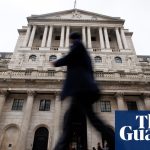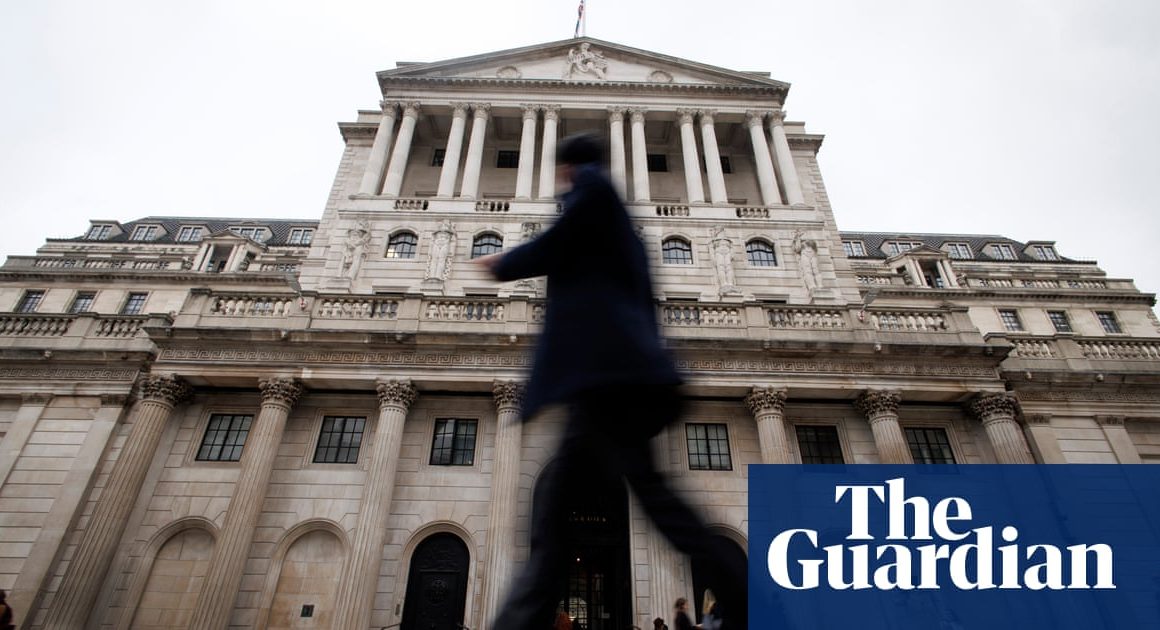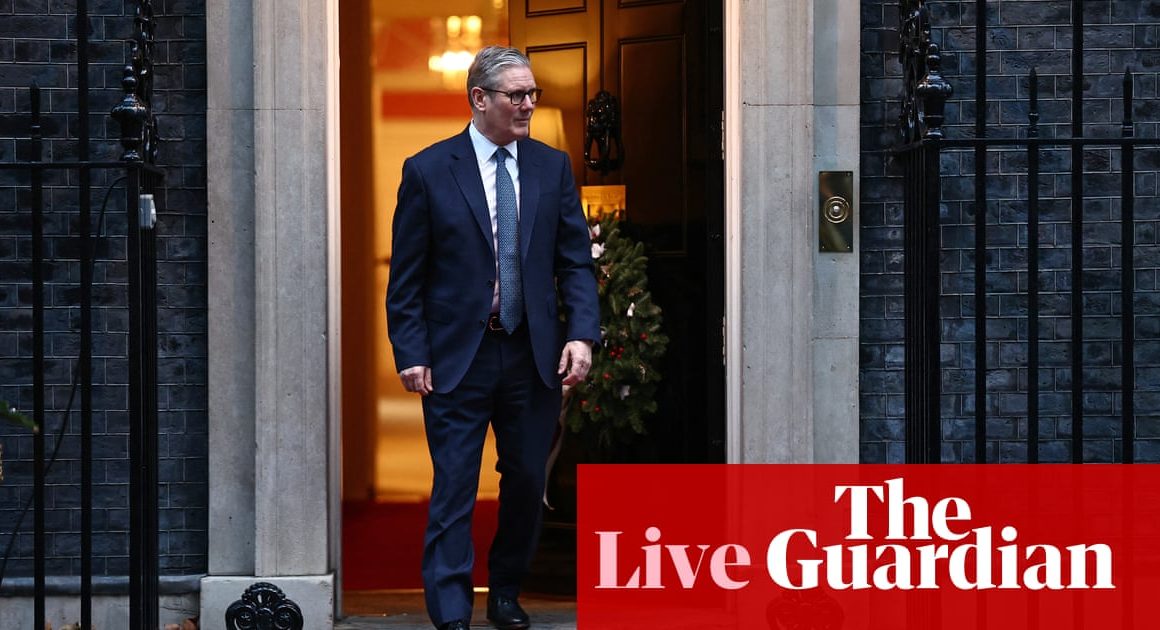Moody’s: UK budget will be ‘additional challenge’ for public finances
The UK government’s increased borrowing will give an “additional challenge” to the public finances, according to influential rating agency Moody’s.
UK gilt yields, effectively the price at which the government can borrow, rose to their highest level this year on Thursday afternoon as markets responded to Rachel Reeves’s budget – the first by a Labour government in 14 years. Investors were responding particularly to the prospect of about £28bn in extra borrowing.
Moody’s said that the budget would not do much to boost UK economic growth, and that there was only a limited buffer if the country faces further financial shocks, in a further sign of the wariness of financial markets towards the government’s plans.
In a note sent to investors, reported by the Financial Times, Moody’s said:
In our view, the increase in borrowing, which is in part supported by a new measure of debt under the fiscal framework, will pose an additional challenge for what are already difficult fiscal consolidation prospects. […]
Furthermore, the extent to which new investment spending can raise growth potential will be limited unless structural constraints are durably addressed which will prove difficult.
Moody’s is one of the three major ratings agencies, alongside S&P and Fitch. Their economists are not privy to any special information or insight on sovereign debt, but their assessments tend to be influential among bond investors
Key events
The US dollar has weakened after the shock drop in non-farm payrolls.
The dollar is down by 0.3% against a trade-weighted basket of currencies after initially climbing over the course of today. The pound is now up 0.5% today against the greenback, while the euro is up 0.1%.
You can see the immediate reaction on this chart showing the performance of the dollar basket today:
Economics professor Justin Wolfers of University of Michigan says that the underlying trend is of slower growth in jobs, but not a signal of a disastrous economic situation.
Hurricane-afflicted jobs numbers are out.
Payrolls grew 12k, about 100k below expectations.
Unemployment stayed steady at 4.1%.As a guess, hurricanes cost about -40k jobs, and the Boeing strike also cost -40k jobs. So *underlying* jobs growth was slower but still reasonable. pic.twitter.com/rvFNmMUP0C
— Justin Wolfers (@JustinWolfers) November 1, 2024
To put this all in perspective: Underlying payrolls growth of +131k is pretty much what we would hope for in the final stages of the soft landing.
You can see this the unemployment numbers, which have been remarkably stable even as inflation plummeted. pic.twitter.com/EKbnSRsZGw
— Justin Wolfers (@JustinWolfers) November 1, 2024
But the headline is nevertheless still a long way below any recent readings thanks to the strikes and hurricanes.
The US unemployment rate remained steady at 4.1%, but it is the non-farm payrolls number that will take up all the attention.
Only 12,000 jobs were added – which will surely be seized on by Donald Trump in the last few days of campaigning ahead of the presidential election. A miss in the forecasts of that magnitude – more than 100,000 jobs – is rare.
The US Bureau of Labor Statistics (BLS) added the important caveat that the jobs reading is the first since Hurricanes Helene and Milton hit the US. The BLS said:
It is likely that payroll employment estimates in some industries were affected by the hurricanes; however, it is not possible to quantify the net effect on the over-the-month change in national employment, hours, or earnings estimates because the establishment survey is not designed to isolate effects from extreme weather events. There was no discernible effect on the national unemployment rate from the household survey.
It also added that “Employment declined in manufacturing due to strike activity” – a reference to the ongoing strike at Boeing in particular.
US economy added only 12,000 jobs in October according to shock numbers
The US economy added far fewer jobs than expected in October, in a shock reading that will raise questions about its momentum days before the presidential election.
Only 12,000 jobs were added in the month, according to the Bureau of Labor Statistics, far below economists expectations of 113,000, and the 254,000 in September.
Tens of millions of Americans have already voted, but we will shortly receive the last big economic update before the US presidential election next Tuesday: non-farm payrolls.
The jobs numbers are a key measure of the US economy, but this month they could be affected by the huge strike at Boeing and the effects of a hurricane hitting Florida.
Whatever the noise, the figures will help to set the narrative for the next day or two as the election campaign enters its most frantic stage.
Bob Savage, head of markets strategy and insights at BNY Mellon, a US investment bank, said:
US October non-farm payrolls expected 110,000 after 254,000 with hurricane and strike noise. The unemployment rate expected steady at 4.1% and the average hourly earnings flat at 4% year-on-year.
Reuters’s poll of economists suggests that the reading will be 113,000, down from 254,000 in September.
A quick check-in on gilt markets: the Labour government will have been eyeing developments nervously after some movement this week, but so far on Friday things have been fairly steady.
The yield on the UK 10-year bond has dropped to 4.42%, down from a high of 4.51% during London trading hours and two basis points (0.02 percentage points) below yesterday’s close. Yields move inversely to prices, so falling yields is a sign of investors buying bonds, after Thursday’s selloff.
The 30-year yield has also dropped by a basis point, while the short-term two-year gilt is down four basis points in today’s trading.
The pound is up by 0.2% against the US dollar, and 0.3% against the euro.
Shreyas Gopal, a strategist at Deutsche Bank, said that the budget should be net positive for the pound, because it will likely make the Bank of England more hawkish – more likely to keep interest rates higher for longer.
Our economist’s base case for next week is that the BoE now retains its language around cuts being “gradual.”
Higher policy rates for longer, driven by a demand stimulus that lifts growth and inflation, ought to be positive for the pound in the current market environment.
America’s two oil giants reported combined profits of more than $13bn (£10bn) for the third quarter as higher production volumes made up for weaker prices.
ExxonMobil made $8.6bn, while Chevron made $4.5bn. Both beat analyst forecasts.
ExxonMobil said it had produced the most oil for a quarter in over 40 years, at 3.2m barrels per day. Chevron said its oil output rose 7% compared with last year thanks to record production in the US, including the West Texas Permian Basin.
Slower global economies have dragged down oil prices in recent months – despite the turmoil in the Middle East and Ukraine. That has hit oil company profits this year, but there is little sign of them slowing down.
Both companies and their rivals have expanded production in the face of warnings from forecasters such as the International Energy Agency that exploration for new oil and gas wells must cease if the world is to hit climate targets to limit global heating to 2 degrees Celsius.
Oil prices have risen by 2% after reports that Iran is preparing an attack on Israel.
Futures prices for Brent crude oil, the North Sea benchmark, have risen by 1.9% to $74.22, while the North American equivalent, West Texas Intermediate, is up 2.1% to $70.73.
US news website Axios reported that Iran was considering the strikes, citing Israeli officials. Investors have been watching the conflicts in the Middle East closely for anything that could mark the start of further escalation. So far Israel’s wars against Hamas in Gaza and Lebanon have not directly affected oil production, for all the horrors of the losses of civilian lives.
UK manufacturing contracted as businesses awaited budget – PMI
The UK manufacturing industry fell into contraction in October as companies paused investments ahead of the budget, according to the closely followed purchasing managers’ index (PMI).
The final reading for British manufacturing dropped to 49.9 points in October, according to S&P Global, below the 50 index level that marks a contraction. The initial “flash” reading had been 50.3.
It was the first time since April that manufacturing activity had contracted, S&P said.
Rob Dobson, director at S&P Global Market Intelligence, said:
UK manufacturing started the final quarter of the year on an uncertain footing amid speculation on government policies ahead of the Budget, which was widely reported to have led to a wait-and-see approach on investment and spending.
This domestic headwind, combined with an ongoing loss of export business, led to the first outright contraction in new work intakes since April. Output growth came close to stalling as a result.
S&P: UK finances ‘constrained’ after budget but growth will be key
Another of the big three rating agencies has published its verdict on the UK budget: S&P Global Ratings said that the UK’s fiscal position is “constrained” – but it also said that public investments – particularly in the health service – could create a “more business-friendly environment”.
The UK faces “elevated budgetary deficits and net general government debt level”, S&P said – although it did not raise its forecasts for budget deficits because it had already taken into account “lingering public spending pressures”.
Chancellor Rachel Reeves’s new fiscal rules gained the unusual backing of the International Monetary Fund this week, because they allow for increased investment. However, S&P said that the rules presented “mixed messages” because they allowed for greater spending, but also that they are more credible on cutting future deficits because they require debt to be government debt to falling within three years. (Previous rules had a five-year timeframe, which meant governments could up load notional tax rises in the future, knowing they were unlikely to have to deal with it themselves.)
The key test of success for Reeves will be growing the economy, S&P said:
The front-loading of spending will mechanically boost growth in the short term, but it’s too early to tell how much this will add to potential output in the long term. On the positive side, investments in infrastructure and planning reforms should create a more business-friendly environment; an improved health service should help bring people back to work as current inactivity remains mainly linked to people who are off sick; and education and childcare investments should improve workers’ skills in the long term. Nonetheless, reaping those potential benefits will also depend on whether the spending is deployed in an effective way.
S&P underlined that Reeves and Starmer have gambled on higher spending generating increased growth. If that does not happen it could prove tricky for the UK:
A hypothetical scenario in which public spending is permanently higher but the quality and accessibility of public services still doesn’t improve enough, could further complicate policy trade-offs in the future. Conversely, a faster improvement in public services could yield greater dividends in terms of lower future pressures and positive growth repercussions.
Moody’s: UK budget will be ‘additional challenge’ for public finances
The UK government’s increased borrowing will give an “additional challenge” to the public finances, according to influential rating agency Moody’s.
UK gilt yields, effectively the price at which the government can borrow, rose to their highest level this year on Thursday afternoon as markets responded to Rachel Reeves’s budget – the first by a Labour government in 14 years. Investors were responding particularly to the prospect of about £28bn in extra borrowing.
Moody’s said that the budget would not do much to boost UK economic growth, and that there was only a limited buffer if the country faces further financial shocks, in a further sign of the wariness of financial markets towards the government’s plans.
In a note sent to investors, reported by the Financial Times, Moody’s said:
In our view, the increase in borrowing, which is in part supported by a new measure of debt under the fiscal framework, will pose an additional challenge for what are already difficult fiscal consolidation prospects. […]
Furthermore, the extent to which new investment spending can raise growth potential will be limited unless structural constraints are durably addressed which will prove difficult.
Moody’s is one of the three major ratings agencies, alongside S&P and Fitch. Their economists are not privy to any special information or insight on sovereign debt, but their assessments tend to be influential among bond investors
Rush of UK property transactions expected ahead of 31 March
Changes to stamp duty by Rachel Reeves in the budget mean we should expect a rush of UK property transactions in the new year until the end of March, according to Nationwide.
That will probably be followed by a period with fewer transactions in the months afterwards.
The chancellor’s decision to remove the temporary increase to the nil rate for stamp duty next April could spark a rush to complete purchases before the changes.
In September 2022, the government temporarily increased the nil rate of stamp duty, the amount before you have to start paying stamp duty on a purchase, for homebuyers, raising the nil rate for first-time buyers from £300,000 to £450,000, and for those buying an additional home from £125,000 to £250,000.
Robert Gardner, Nationwide’s chief economist, said:
The main impact of the stamp duty changes is likely to be on the timing of property transactions, as purchasers aim to ensure their house purchases complete before the tax change takes effect.
This will lead to a jump in transactions in the first three months of 2025 (especially March), and a corresponding period of weakness in the following three to six months, as occurred in the wake of previous stamp duty changes.
The biggest mover on the FTSE 100 this morning is Reckitt Benckiser, the maker of products ranging from Dettol to Strepsils.
Reckitt’s shares are up 10% after a US court ruling boosted its baby formula subsidiary, Mead Johnson.
Here’s the Reuters report on the ruling from last night:
Abbott and Reckitt unit Mead Johnson are not responsible for a young boy’s debilitating intestinal disease, a jury found on Thursday in a lawsuit accusing them of failing to warn of their premature baby formulas’ risks, a victory for the two companies following large losses in similar trials.
At the five-week trial in St. Louis, Missouri state court, lawyers for plaintiff Kaine Whitfield had urged jurors to award more than $6.2 billion.
The lawsuit, brought on Kaine’s behalf by his mother, Elizabeth Whitfield, alleged that the companies failed to warn that their specialized formulas used by newborn intensive care units in hospitals could cause necrotizing enterocolitis, a disease that almost exclusively affects premature infants and has an estimated mortality rate of more than 20%.
The UK’s chief secretary to the Treasury, Darren Jones, has said that the UK is seeing a normal market response to the budget, after the “PTSD” from the chaos following Liz Truss’s 2022 “mini-budget”.
Asked about the market response to the budget, the Jones told Sky News that “markets always respond to budgets in the normal way”.
There’s a lot of new information about the economy and the nation’s finances presented to Parliament, and it’s normal for markets to respond.
I think we’ve all got PTSD from Liz Truss and just let’s compare the two different scenarios, because they’re very, very different: So, under Liz Truss, as we saw, they sacked permanent secretary, they ignored the independent Office for Budget Responsibility.
They announced £45bn of unfunded tax cuts and said they were only just getting started. And then the market went mad and we all know what happened.
Completely different in contrast to now.
Stock markets across Europe have gained ground. The FTSE 100 in London is up by 0.4%.
Here are the opening snaps from across the rest of Europe:
-
EUROPE’S STOXX 600 UP 0.1%
-
GERMANY’S DAX FLAT
-
FRANCE’S CAC 40 UP 0.2%; SPAIN’S IBEX UP 0.1%
-
EURO STOXX INDEX UP 0.1%; EURO ZONE BLUE CHIPS UP 0.1%
As trading in London has opened, yields on the UK 10-year and the 30-year have risen by about four basis points (0.04 percentage points) apiece. But they still remain just below the high for the year hit on Thursday.
That left the 10-year gilt at 4.477%, and the 30-year at 4.913%.
UK house prices slow in October; government borrowing costs nudge annual high
Good morning, and welcome to our live coverage of business, economics and financial markets.
UK house price growth slowed in October ahead of Wednesday’s budget, surprising economists who had expected faster increases, according to one of the key measures collected by a lender.
House prices grew by 0.1% in October, according to the Nationwide building society. That was less than the 0.3% rate that economists polled by Reuters.
The annual rate of growth slowed from 3.2% in September to 2.4% in October, below the 2.8% expected by economists.
Robert Gardner, Nationwide’s chief economist, said:
Housing market activity has remained relatively resilient in recent months, with the number of mortgage approvals approaching the levels seen pre-pandemic, despite the significantly higher interest rate environment.
UK debt yields revisit year high after budget
UK bond yields once more touched their highest point this year on Friday, as investors continued to digest the implications of the first Labour budget in 14 years.
The yield – effectively the UK government’s borrowing cost – on the benchmark 10-year bond reached 4.526% in global trading on Friday, matching the level hit on Thursday in the aftermath of Rachel Reeves’s budget statement as investors predicted a slower pace of interest rate cuts from the Bank of England. Since then it has fallen back slightly to 4.456%.
Scrutiny of bond market movements has been particularly intense after the budget because of the large borrowing set out by Reeves, alongside major tax increases. However, while there has been a noticeable reaction in the market for UK government bonds, also known as gilts, it has not so far been comparable to the turmoil following the budget of Liz Truss and Kwasi Kwarteng in 2022.
The below chart shows the UK 10-year gilt yield over the last three months: yields (which move inversely to prices) have risen appreciably, but the post-budget movements have not been dramatic.
We will update throughout the day on movements.
The agenda
-
9:30am GMT: S&P Global UK manufacturing purchasing managers’ index (October; final reading; previous: 51.5; consensus: 50.3)
-
12:30pm GMT: US non-farm payrolls (October: prev.: 254,000 new jobs; cons.: 113,000)
-
12:30pm GMT: US unemployment (October: prev.: 4.1%; cons.: 4.1%)











